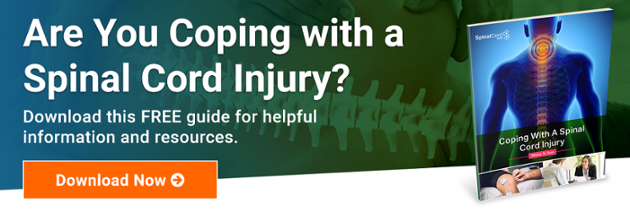What You Should Know about C4 Spinal Cord Injuries
There is a lot to learn and know about any type of spinal cord injury (SCI) — everything from the effects of a spinal cord injury to a survivor’s potential rate of recovery to how the injury impacts their daily life. Every level of the cervical spinal cord that remains uninjured means an increased likelihood of the individual achieving a higher level of recovery.

Have you or someone you love sustained a traumatic C4 spinal cord injury? Our goal in this article is to provide you with the information you need to know about cervical spinal cord injuries affecting the C4 vertebral region, how they differ from other SCIs, and what recovery from C4 spinal cord injuries can entail.
What Is a C4 Spinal Cord Injury?
According to Johns Hopkins Medicine, cervical and thoracic spinal cord injuries are the most common types of spinal cord injury. A cervical spinal cord injury is considered the most severe and deadly type of SCI. This is because the higher up the damage occurs on the spinal cord, and the more complete the injury, the higher the risk of complete paralysis and death. A C4 spinal cord injury occurs when damage is dealt about mid-way down the cervical spinal cord — the topmost portion of the spinal cord that is located in the neck and upper shoulders.
Complete vs. Incomplete C4 Spinal Cord Injuries
Although the term “incomplete” generally has a negative connotation, in the case of a spinal cord injury, an incomplete spinal cord injury may preferable. Incomplete spinal cord injuries run the gamut, however — they can be mild in the sense that they cause little to no muscle weakness, or they can be so severe that they are nearly indistinguishable from a complete SCI.
Symptoms and Complications from a C4 Spinal Cord Injury
Depending on the level and type of SCI sustained, some of the symptoms and secondary complications will vary. Survivors of a C4 spinal cord injury may experience any or all of the following:
- A limited range of motion below the injury site;
- Quadriplegia or tetraplegia — paralysis in the hands, arms, torso, and legs;
- Bladder or bowel function issues;
- Loss of control of the abdominal and intercostal muscles in the torso, eliminating the ability to cough or sneeze; and
- Retention of some head and neck mobility, as well as limited shoulder movement.
When someone suffers a cervical spinal cord injury at the C4 level or higher, they may need a personal care assistant to help with everyday tasks such as getting out of bed, getting dressed, bathing, and eating. They may also require a ventilator to provide breathing assistance because this section of the spinal cord plays a role in the control and function of the diaphragm. The diaphragm, a major muscle that enables breathing, is controlled by the phrenic nerve. According to Joseph Krainin, M.D., a board-certified sleep medicine physician, the phrenic nerve is comprised of inputs from the C3, C4, and C5 nerve roots (primarily C4).
One of the conditions that can result from a C4 spinal cord injury is known as sleep-related hypoxemia. According to a 2019 study on sleep disordered breathing (SDB) in people with spinal cord injuries, "Individuals living with spinal cord injury or disease (SCI/D) are at increased risk for sleep-disordered breathing (SDB), with a prevalence that is three- to fourfold higher than the general population."
How a C4 Cervical Spinal Cord Injury Differs from Other SCIs
The further down the spinal cord injury occurs, the greater the chance of recovery for the patient. For example, someone with a C1 or C3 spinal cord injury will have more limitations than someone with C6 spinal cord injury. Each level of the cervical spinal cord controls different functions throughout the body as part of the body’s central nervous system (CNS). This means that, even though the injuries occur within close nerve proximity, someone with a C4 spinal cord injury will have a different outcome than someone with a C6 spinal cord injury.
C4 Spinal Cord Injury Treatment and Recovery
Every spinal cord injury is different. Two people with the same level of spinal cord injury can have significantly different experiences, limitations, and levels of recovery. Much of the success of a patient’s C4 spinal cord injury recovery is dependent on the level of medical care they receive immediately following the incident. The neck and spinal cord must be stabilized as much as possible, and medications or surgery may be necessary to help reduce swelling and inflammation.
Other C4 spinal cord injury treatment options include epidural electrical stimulation, participation in experimental stem cell research, cold therapy (therapeutic hypothermia), and engaging in activity-based therapy sessions
Remember: You Are Not Alone and Have Access to SCI Information and Support
We are here for you. SpinalCord.com is an online community for spinal cord injury survivors and their families. We provide a wealth of useful information, news about SCI research, and information about a person’s legal rights after sustaining a spinal cord injury. Sponsored by Swope, Rodante P.A., a catastrophic injury law firm based in Florida, this site aims to serve as an informational resource for people with catastrophic injuries.
To learn more about coping with a spinal cord injury, including a cervical spinal cord injury, be sure to check out our complimentary guide by clicking on the link below.
Stay Updated on Advancements On Traumatic Brain &
Spinal Cord Injuries
About the Author





